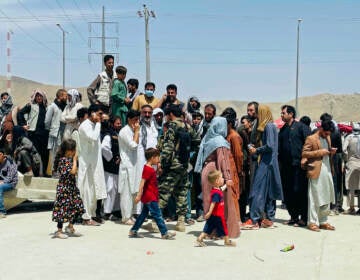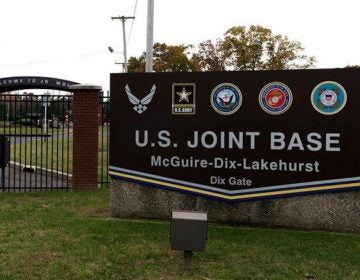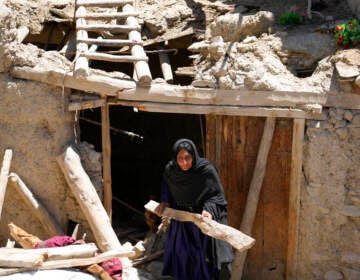US officials: 11 Marines and medic killed in Afghanistan
Western nations had warned of a possible attack on Kabul’s airport in the waning days of the massive evacuation efforts.
At least 12 U.S. service members were killed in the Afghanistan bombings, including 11 Marines and one Navy medic, according to two U.S. officials. Officials say a number of US military troops were wounded. They warn, however, that the numbers may grow.
THIS IS A BREAKING NEWS UPDATE. AP’s earlier story follows below.
KABUL, Afghanistan (AP) — Two suicide bombers and gunmen attacked crowds of Afghans flocking to Kabul’s airport Thursday, transforming a scene of desperation into one of horror in the waning days of an airlift for those fleeing the Taliban takeover. At least 13 people were killed and dozens wounded, Russian officials and aid workers said.
Several Marines were killed and a number of other American military were wounded, a U.S. official said. It was not clear if those deaths were included in the Russian toll.
One of the bombers struck people standing knee-deep in a wastewater canal under the sweltering sun, throwing bodies into the fetid water. Those who moments earlier had hoped to get on flights out could be seen carrying the wounded to ambulances in a daze, their own clothes darkened with blood.
A second U.S. official said the complex attack was believed to have been carried out by the Islamic State group. The IS affiliate in Afghanistan is far more radical than the Taliban, who recently took control of the country in a lightning blitz and condemned the attack.
Western officials had warned of a major attack, urging people to leave the airport, but that advice went largely unheeded by Afghans desperate to escape the country in the last few days of an American-led evacuation before the U.S. officially ends its 20-year presence on Aug. 31.
Russia’s Foreign Ministry gave the first official casualty count, but the numbers continued to grow. Emergency, an Italian charity that operates hospitals in Afghanistan, said it had received 60 patients wounded in the airport attack, in addition to 10 who were dead when they arrived.
“Surgeons will be working into the night,” said Marco Puntin, the charity’s manager in Afghanistan. The wounded overflowed the triage zone into the physiotherapy area and more beds were being added, he said.
Pentagon spokesman John Kirby also confirmed the blasts and said there were casualties, including among members of the military, but gave no figure. He said one explosion was near an airport entrance and another was a short distance away by a hotel.
One official, who spoke on condition of anonymity to discuss ongoing military operations, said several Marines were killed. It wasn’t clear if other U.S. military troops were among the dead. American officials have said that information is still coming in and they are trying to determine exact numbers of casualties.
Even as the area was hit, evacuation flights continued to take off from Kabul airport.
Adam Khan was waiting nearby when he saw the first explosion outside what’s known as the Abbey gate. He said several people appeared to have been killed or wounded, including some who were maimed.
The second blast was at or near Baron Hotel, where many people, including Afghans, Britons and Americans, were told to gather in recent days before heading to the airport for evacuation.
A former Royal Marine who runs an animal shelter in Afghanistan says he and his staff were caught up in the aftermath of the blast near the airport.
“All of a sudden we heard gunshots and our vehicle was targeted, had our driver not turned around he would have been shot in the head by a man with an AK-47,” Paul “Pen” Farthing told Britain’s Press Association news agency.
Farthing is trying to get staff of his Nowzad charity out of Afghanistan, along with the group’s rescued animals.
He is among thousands trying to flee. Over the last week, the airport has been the scene of some of the most searing images of the chaotic end of America’s longest war and the Taliban’s takeover, as flight after flight took off carrying those who fear a return to the militants’ brutal rule. When the Taliban were last in power, they confined women largely to their home and widely imposed draconian restrictions.
Already, some countries have ended their evacuations and begun to withdraw their soldiers and diplomats, signaling the beginning of the end of one of history’s largest airlifts. The Taliban have insisted foreign troops must be out by America’s self-imposed deadline of Aug. 31 — and the evacuations must end then, too.
In Washington, U.S. President Joe Biden spent much of the morning in the secure White House Situation Room where he was briefed on the explosions and conferred with his national security team and commanders on the ground in Kabul.
Overnight, warnings emerged from Western capitals about a threat from IS, which has seen its ranks boosted by the Taliban’s freeing of prisoners during its advance through Afghanistan.
Shortly before the attack, the acting U.S. ambassador to Kabul, Ross Wilson, said the security threat at the Kabul airport overnight was “clearly regarded as credible, as imminent, as compelling.” But in an interview with ABC News, he would not give details.
Late Wednesday, the U.S. Embassy warned citizens at three airport gates to leave immediately due to an unspecified security threat. Australia, Britain and New Zealand also advised their citizens Thursday not to go to the airport.
Taliban spokesman Zabihullah Mujahid denied that any attack was imminent at the airport, where the group’s fighters have deployed and occasionally used heavy-handed tactics to control the crowds. After the attack, he appeared to shirk blame, noting the airport is controlled by U.S. troops.
Before the blast, the Taliban sprayed a water cannon at those gathered at one airport gate to try to drive the crowd away, as someone launched tear gas canisters elsewhere.
Nadia Sadat, a 27-year-old Afghan, carried her 2-year-old daughter with her outside the airport. She and her husband, who had worked with coalition forces, missed a call from a number they believed was the State Department and were trying to get into the airport without any luck. Her husband had pressed ahead in the crowd to try to get them inside.
“We have to find a way to evacuate because our lives are in danger,” Sadat said. “My husband received several threatening messages from unknown sources. We have no chance except escaping.”
Aman Karimi, 50, escorted his daughter and her family to the airport, fearful the Taliban would target her because of her husband’s work with NATO.
“The Taliban have already begun seeking those who have worked with NATO,” he said. “They are looking for them house-by-house at night.”
The Sunni extremists of IS, with links to the group’s more well-known affiliate in Syria and Iraq, have carried out a series of brutal attacks, mainly targeting Afghanistan’s Shiite Muslim minority, including a 2020 assault on a maternity hospital in Kabul in which they killed women and infants.
The Taliban have fought against Islamic State militants in Afghanistan, where the Taliban have wrested back control nearly 20 years after they were ousted in a U.S.-led invasion. The Americans went in following the 9/11 attacks, which al-Qaida orchestrated while being sheltered by the group.
Amid the warnings and the pending American withdrawal, Canada ended its evacuations, and European nations halted or prepared to stop their own operations.
“The reality on the ground is the perimeter of the airport is closed. The Taliban have tightened the noose. It’s very, very difficult for anybody to get through at this point,” Canadian General Wayne Eyre, the country’s acting Chief of Defense Staff, said ahead of the attack.
Lt. Col. Georges Eiden, Luxembourg’s army representative in neighboring Pakistan, said that Friday would mark the official end for U.S. allies. But two Biden administration officials denied that was the case.
A third official said that the U.S. worked with its allies to coordinate each country’s departure, and some nations asked for more time and were granted it.
“Most depart later in the week,” he said, while adding that some were stopping operations Thursday. All three officials spoke on condition of anonymity because they were not authorized to discuss the information publicly.
Danish Defense Minister Trine Bramsen bluntly warned earlier: “It is no longer safe to fly in or out of Kabul.”
Denmark’s last flight has already departed, and Poland and Belgium have also announced the end of their evacuations. The Dutch government said it had been told by the U.S. to leave Thursday.
But Kirby, the Pentagon spokesman, said some planes would continue to fly.
“Evacuation operations in Kabul will not be wrapping up in 36 hours. We will continue to evacuate as many people as we can until the end of the mission,” he said in a tweet.
The Taliban have said they’ll allow Afghans to leave via commercial flights after the deadline next week, but it remains unclear which airlines would return to an airport controlled by the militants. Turkish presidential spokesman Ibrahim Kalin said talks were underway between his country and the Taliban about allowing Turkish civilian experts to help run the facility.
WHYY is your source for fact-based, in-depth journalism and information. As a nonprofit organization, we rely on financial support from readers like you. Please give today.






